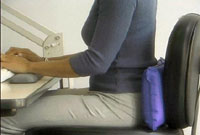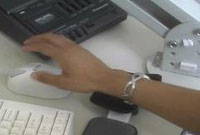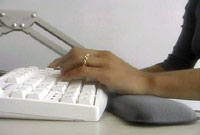 | Lower the height of the chair so that your back
touches the back of the chair and you are comfortable. |
 | Your feet should rest firmly on the floor
slightly in front of you. |
 | Center your keyboard in front of your monitor.
Your eyes should be at the same level as the tool bar. |
 | Keep the keyboard and mouse close to the edge of
the desk. |
 | Keyboard and mouse should be positioned so your
arms fall naturally at your sides, with wrists straight out in front
while typing/mousing. |
 | Support your wrist and forearms with a gel pad or
wrist support. |
 | Avoid repetitive gripping of the mouse.
|
 | Keep frequently used items close - avoid reaching
for anything! |
 | Do wrist, finger, and hand exercises. |
Sitting in a chair places 400 pounds of pressure on
your lower back. If your back is unable to support your body, the
strain which it is undergoing will affect other areas of your body as
well, including your hands, arms, and wrists.
There are a number of steps you can take to reduce
strain as you work. First, consider your desk posture. Be sure to sit
with your back low against the back of your chair. You may need to
roll up a towel or buy a lumbar roll to maintain the natural curve of
your spine. Be sure the back of the head is lifted, the breastbone is
lifted, and the lower back is supported. Your back should be angled
backward a few degrees to widen the angle between the torso and the
thighs: this increases blood flow plus reduces the compression of the
spine.
Your arms should be relaxed and loose at your sides,
with your forearms and hands parallel to the floor. The correct wrist
and hand position should create a 90-degree angle and the wrists
should not be flexed or extended, but rather should be in a neutral
position. Keep your thighs at a right angle to your torso, and your
knees at a right angle to your thighs.
Be sure to change your position frequently, and
avoid using excessive force while typing at the keyboard. Over time, a
heavy typing style could aggravate hand, wrist, or finger pain
symptoms by placing joints and tissues under continual stress. Lastly,
consider the use of ergonomic devices such as back supports, mouse
wristpads, and keyboard gel wristpads (see illustrations at left).
More detailed coverage of this topic is available in
the video
Say Goodbye to Wrist Pain, which is available through this
web site.


